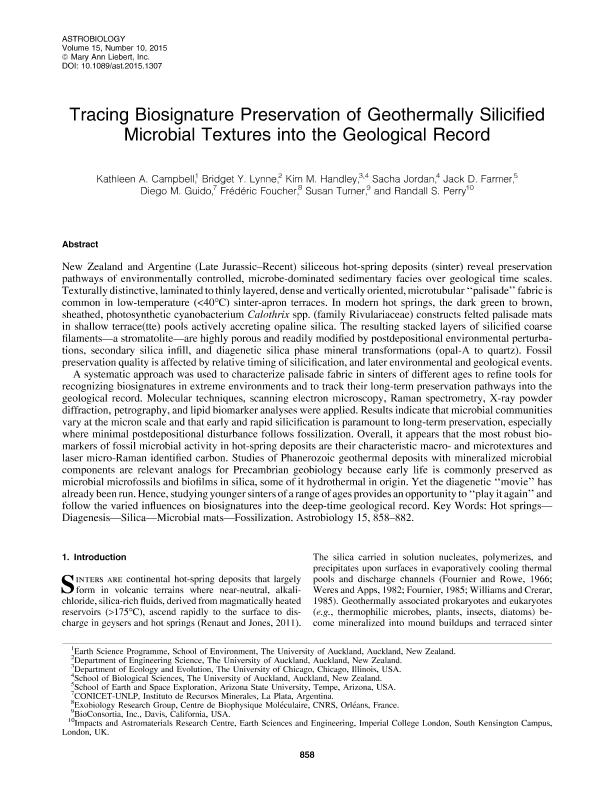Artículo
Tracing Biosignature Preservation of Geothermally Silicified Microbial Textures into the Geological Record
Campbell, Kathleen; Lynne, Bridget Y.; Handley, Kim M.; Jordan, Sacha; Farmer, Jack D.; Guido, Diego Martin ; Foucher, Frédéric; Turner, Susan; Perry, Randall S.
; Foucher, Frédéric; Turner, Susan; Perry, Randall S.
 ; Foucher, Frédéric; Turner, Susan; Perry, Randall S.
; Foucher, Frédéric; Turner, Susan; Perry, Randall S.
Fecha de publicación:
10/2015
Editorial:
Mary Ann Liebert
Revista:
Astrobiology
ISSN:
1531-1074
Idioma:
Inglés
Tipo de recurso:
Artículo publicado
Clasificación temática:
Resumen
New Zealand and Argentine (Late Jurassic-Recent) siliceous hot-spring deposits (sinter) reveal preservation pathways of environmentally controlled, microbe-dominated sedimentary facies over geological time scales. Texturally distinctive, laminated to thinly layered, dense and vertically oriented, microtubular "palisade" fabric is common in low-temperature (<40°C) sinter-apron terraces. In modern hot springs, the dark green to brown, sheathed, photosynthetic cyanobacterium Calothrix spp. (family Rivulariaceae) constructs felted palisade mats in shallow terrace(tte) pools actively accreting opaline silica. The resulting stacked layers of silicified coarse filaments a stromatolite are highly porous and readily modified by postdepositional environmental perturbations, secondary silica infill, and diagenetic silica phase mineral transformations (opal-A to quartz). Fossil preservation quality is affected by relative timing of silicification, and later environmental and geological events. A systematic approach was used to characterize palisade fabric in sinters of different ages to refine tools for recognizing biosignatures in extreme environments and to track their long-term preservation pathways into the geological record. Molecular techniques, scanning electron microscopy, Raman spectrometry, X-ray powder diffraction, petrography, and lipid biomarker analyses were applied. Results indicate that microbial communities vary at the micron scale and that early and rapid silicification is paramount to long-term preservation, especially where minimal postdepositional disturbance follows fossilization. Overall, it appears that the most robust biomarkers of fossil microbial activity in hot-spring deposits are their characteristic macro-and microtextures and laser micro-Raman identified carbon. Studies of Phanerozoic geothermal deposits with mineralized microbial components are relevant analogs for Precambrian geobiology because early life is commonly preserved as microbial microfossils and biofilms in silica, some of it hydrothermal in origin. Yet the diagenetic "movie" has already been run. Hence, studying younger sinters of a range of ages provides an opportunity to "play it again" and follow the varied influences on biosignatures into the deep-time geological record.
Palabras clave:
Diagenesis
,
Fossilization. Astrobiology 15
,
Hot Springs
,
Microbial Mats
,
Silica
Archivos asociados
Licencia
Identificadores
Colecciones
Articulos(CCT - LA PLATA)
Articulos de CTRO.CIENTIFICO TECNOL.CONICET - LA PLATA
Articulos de CTRO.CIENTIFICO TECNOL.CONICET - LA PLATA
Citación
Campbell, Kathleen; Lynne, Bridget Y.; Handley, Kim M.; Jordan, Sacha; Farmer, Jack D.; et al.; Tracing Biosignature Preservation of Geothermally Silicified Microbial Textures into the Geological Record; Mary Ann Liebert; Astrobiology; 15; 10; 10-2015; 858-882
Compartir
Altmétricas



